Interaction of Urban Rivers and Green Space Morphology to Mitigate the Urban Heat Island Effect: Case-Based Comparative Analysis
Abstract
:1. Introduction
2. Study Area and Methodology
2.1. Study Area
2.2. Data and Methods
2.2.1. Research Framework
2.2.2. Land Surface Temperature
2.2.3. River Width Classification and Green Space Extraction in the Buffer Zone
- (1)
- Width-I: the first classification pertains to rivers with a width of less than 30 m and the buffer zone is 500–800 m from the riverbank;
- (2)
- Width-II: the second classification pertains to rivers with a width between 30 and 50 m, and the buffer zone is 800–1500 m from the riverbank;
- (3)
- Width-III: the third classification pertains to rivers with a width between 50 and 80 m, and the buffer zone is 1000–1700 m from the riverbank; and
- (4)
- Width-IV: the fourth classification pertains to rivers with a width greater than 100 m. The width of the river channel in the study area is not in the range of 80–100 m. The buffer zone is 1500–2500 m from the riverbank.
2.2.4. Quantification of Multi-Dimensional Spatial Impact Factors of Blue–Green Spaces
- (1)
- Spatial Morphological Variables
- (2)
- Spatial Structural Variables
2.2.5. Analysis of the Influence of Spatial Morphological Structure Factors
- (1)
- Boosted Regression Tree (BRT) model
- (2)
- Criteria for threshold of marginal effect analysis
- a.
- The inclination of ME curve: The inclination of the ME curve represented the severity of the changes in marginal utility. When the curve took on an ascending trend with great inclination degree, the marginal utility increase was very large; When the curve took on an ascending trend with gradual inclination degree, the marginal utility increase was weak; When the curve inclination was a declining trend, the marginal effect of cooling effect was decrease.
- b.
- The optimal distance of marginal utility: The first inflection point where the inclination degree of the ME curve changed from great ascending trend to gradual ascending trend. It indicated that the marginal utility of synergistic cooling effect of blue–green space was in the optimal growth state, and the corresponding D value is the optimal distance with the most economic utility of blue–green space to reach the good cooling effect.
- c.
- The maximum distance of marginal utility: This inflection point was the peak values of the marginal effect curve from an ascending trend to a declining trend. It represented the maximum value of the synergistic marginal utility of blue–green space. When the curve was in the gradual ascending range, the marginal utility of waterbody cooling effect declined with the increase of distance, and the ME of green space continues to produce cooling effect. The holistic synergistic cooling effect of riverfront blue–green space increased slowly and reached the maximum cooling effect at the inflection point.
- d.
- The threshold distance of cooling effect: The ME curve showed a declining trend, and after it declined to the lowest value, the curve appeared irregular alteration. This inflection of the lowest value represented the longest distance of the blue–green synergistic cooling effect. The declining interval of ME curve presented the ME attenuation of cooling effect from both blue space and green space. The position of the lowest attenuation value of the curve was no longer affected by the distance from the synergistic ME of blue–green spaces, namely, the threshold distance of the blue–green synergistic cooling effect was identified.
- (3)
- Classification of spatial morphological group types (MG types) and correlation analysis for the LST
- The grade level of a single spatial variable was classified (Table 2). Each spatial variable was assigned different grade levels. The value interval was identified based on the effect of the variables on the spatial differentiation interval of the LST values.
- The MG types were grouped. A subcategory of each factor was randomly combined to form MG types with different structural and morphological characteristics. The specific combinational logic and type delimitations are illustrated in Figure 5.
- c.
- The correlation characteristics between the MG types with great cooling effects and LST values were identified. The temperature standard of highly suitable green spaces was considered to reflect the residents’ general body temperature that can meet the survival needs of residents. The standard of high-temperature heat waves determined by the Chinese government involves a maximum daily temperature of 35 °C as the limit for green space cooling optimization. The results show that in August, the difference between the LST and air temperature is approximately 1.8 °C [77]. In this study, the data group with an LST lower than 36.8 °C was selected. According to the increasing sequence of the LST, the correlation characteristics between different Mg types and LST were analyzed by observing the classification of the spatial composition of the corresponding MG types.
3. Results
3.1. Width-I Rivers (20–30 m)
3.1.1. Contribution of Each Spatial Variable to the LST
3.1.2. Relationship between D (Distance of the Waterfront Green Space from the Riverbank) and LST Values
3.1.3. Morphological Group (MG) Types and LST Values
3.2. Width-II Rivers (30–50 m)
3.2.1. Contribution of Each Spatial Variable to the LST
3.2.2. D Factors and LST Values
3.2.3. MG Types and LST Values
3.3. Width-III Rivers (30–50 m)
3.3.1. Contribution of Each Spatial Variable to the LST
3.3.2. D Factors and LST Values
3.3.3. MG Types and LST Values
3.4. Width-IV Rivers (Width of More than 100 m)
3.4.1. Contribution of Each Spatial Variable to the LST
3.4.2. D Factors and LST Values
3.4.3. MG Types and LST Values
4. Discussion
4.1. Difference in the Cooling Effect of the River Width Scale
4.2. The Importance of Greenspace Morphological Factors in Waterfront Areas
- In the index system of the LST-related morphological factors of waterfront green spaces, Fv and area considerably influenced the LST. The total contribution ratio of the two factors was more than 60% and Fv was the primary factor affecting the LST, as observed in the previous studies [18].
- In the river width classification studies, the D factor exhibited a negative correlation with the LST. In particular, the regression relationship between D and LST, and the ME was below zero for the Width-II and Width-IV rivers. This finding reflected the fact that the water cold island effect decreased with increasing D, but the synergy of the blue–green space increased the intensity of the marginal effect. When a constant negative correlation existed between the two aspects, the UGCI strengthened the UWCI, and the cooling values exceeded the attenuation values when D was large.
4.3. Differences Compared to the Existing Studies
4.4. Limitations of the Present Study
5. Conclusions
Author Contributions
Funding
Institutional Review Board Statement
Informed Consent Statement
Acknowledgments
Conflicts of Interest
Abbreviations
| urban heat island | UHI |
| urban cooling effect | UCI |
| urban cooling island of green space | UGCI |
| waterbody cooling island | WCI |
| land surface temperature | LST |
| boosted regression trees | BRT |
| morphological group | MG |
| marginal effect | ME |
| normalized difference vegetation index | NDVI |
| normalized difference built-up index | NDBI |
| sky view factors | SVF |
| United States geological survey | USGS |
| thermal infrared sensor | TIRS |
| fast line-of-sight atmospheric analysis of spectral hypercubes | FLAASH |
| radiative transfer equation | RTE |
| mono-window algorithm | MWA |
| single-channel method | SCM |
| ground control points | GCPs |
| area | A |
| landscape shape index | LSI |
| fractional cover values of vegetation space | Fv |
| width of river | Wd |
| distance to riverbank | D |
| probability of connectivity | PC |
| decrease in the probability of connectivity | dPC |
| connectivity degree | Cd |
| location of greenspace | LG |
References
- Oke, T.R. The energetic basis of the urban heat island. Q. J. R. Meteorol. Soc. 1982, 108, 1–24. [Google Scholar] [CrossRef]
- Voogt, J.A.; Oke, T.R. Thermal remote sensing of urban climates. Remote Sens. Environ. 2003, 86, 370–384. [Google Scholar] [CrossRef]
- Zhao, S.; Zhou, D.; Liu, S. Data concurrency is required for estimating urban heat island intensity. Environ. Pollut. 2016, 208, 118–124. [Google Scholar] [CrossRef]
- Aflaki, A.; Mirnezhad, M.; Ghaffarianhoseini, A.; Ghaffarianhoseini, A.; Omrany, H.; Wang, Z.-H.; Akbari, H. Urban heat island mitigation strategies: A state-of-the-art review on Kuala Lumpur, Singapore and Hong Kong. Cities 2017, 62, 131–145. [Google Scholar] [CrossRef] [Green Version]
- Skelhorn, C.; Lindley, S.; Levermore, G. The impact of vegetation types on air and surface temperatures in a temperate city: A fine scale assessment in Manchester, UK. Landsc. Urban Plan. 2014, 121, 129–140. [Google Scholar] [CrossRef]
- Grimmond, C.S.B.; Oke, T.R. Heat storage in urban areas: Local-scale observations and evaluation of a simple model. J. Appl. Meteorol. 1999, 38, 922–940. [Google Scholar] [CrossRef]
- Sailor, D.J. A review of methods for estimating anthropogenic heat and moisture emissions in the urban environment. Int. J. Climatol. 2011, 31, 189–199. [Google Scholar] [CrossRef]
- Tallis, M.; Taylor, G.; Sinnett, D.; Freer-Smith, P. Estimating the removal of atmospheric particulate pollution by the urban tree canopy of London, under current and future environments. Landsc. Urban Plan. 2011, 103, 129–138. [Google Scholar] [CrossRef]
- Akbari, H.; Pomerantz, M.; Taha, H. Cool surfaces and shade trees to reduce energy use and improve air quality in urban areas. Sol. Energy 2001, 70, 295–310. [Google Scholar] [CrossRef]
- Taha, H. Urban climates and heat islands: Albedo, evapotranspiration, and anthropogenic heat. Energy Build. 1997, 25, 99–103. [Google Scholar] [CrossRef] [Green Version]
- Chan, E.Y.Y.; Goggins, W.B.; Kim, J.J.; Griffiths, S.M. A study of intracity variation of temperature-related mortality and socioeconomic status among the Chinese population in Hong Kong. J. Epidemiol. Community Health 2010, 66, 322–327. [Google Scholar] [CrossRef] [PubMed] [Green Version]
- Chen, A.; Yao, L.; Sun, R.; Chen, L. How many metrics are required to identify the effects of the landscape pattern on land surface temperature? Ecol. Indic. 2014, 45, 424–433. [Google Scholar] [CrossRef]
- Moyer, A.N.; Hawkins, T.W. River effects on the heat island of a small urban area. Urban Clim. 2017, 21, 262–277. [Google Scholar] [CrossRef]
- Gunawardena, K.R.; Wells, M.J.; Kershaw, T. Utilising green and bluespace to mitigate urban heat island intensity. Sci. Total Environ. 2017, 584–585, 1040–1055. [Google Scholar] [CrossRef] [PubMed]
- Wu, J.; Li, C.; Zhang, X.; Zhao, Y.; Liang, J.; Wang, Z. Seasonal variations and main influencing factors of the water cooling islands effect in Shenzhen. Ecol. Indic. 2020, 117, 106699. [Google Scholar] [CrossRef]
- Theeuwes, N.E.; Solcerová, A.; Steeneveld, G.J. Modeling the influence of open water surfaces on the summertime temperature and thermal comfort in the city. J. Geophys. Res. Atmos. 2013, 118, 8881–8896. [Google Scholar] [CrossRef] [Green Version]
- Yu, Z.; Yang, G.; Zuo, S.; Jørgensen, G.; Koga, M.; Vejre, H. Critical review on the cooling effect of urban blue-green space: A threshold-size perspective. Urban For. Urban Green. 2020, 49, 126630. [Google Scholar] [CrossRef]
- Fan, H.; Yu, Z.; Yang, G.; Liu, T.Y.; Hung, C.H.; Vejre, H. How to cool hot-humid (Asian) cities with urban trees? An optimal landscape size perspective. Agric. For. Meteorol. 2019, 265, 338–348. [Google Scholar] [CrossRef]
- Du, H.; Song, X.; Jiang, H.; Kan, Z.; Wang, Z.; Cai, Y. Research on the cooling island effects of water body: A case study of Shanghai, China. Ecol. Indic. 2016, 67, 31–38. [Google Scholar] [CrossRef]
- Lin, B.-S.; Lin, Y.-J. Cooling Effect of Shade Trees with Different Characteristics in a Subtropical Urban Park. HortScience 2010, 45, 83–86. [Google Scholar] [CrossRef] [Green Version]
- Skoulika, F.; Santamouris, M.; Kolokotsa, D.; Boemi, S.-N. On the thermal characteristics and the mitigation potential of a medium size urban park in Athens, Greece. Landsc. Urban Plan. 2014, 123, 73–86. [Google Scholar] [CrossRef]
- Yu, Z.; Guo, X.; Jørgensen, G.; Vejre, H. How can urban green spaces be planned for climate adaptation in subtropical cities? Ecol. Indic. 2017, 82, 152–162. [Google Scholar] [CrossRef]
- Jaganmohan, M.; Knapp, S.; Buchmann, C.; Schwarz, N. The Bigger, the Better? The Influence of Urban Green Space Design on Cooling Effects for Residential Areas. J. Environ. Qual. 2016, 45, 134–145. [Google Scholar] [CrossRef] [PubMed]
- Yang, G.; Yu, Z.; Jørgensen, G.; Vejre, H. How can urban blue-green space be planned for climate adaption in high-latitude cities? A seasonal perspective. Sustain. Cities Soc. 2020, 53, 101932. [Google Scholar] [CrossRef]
- Sun, R.; Chen, L. How can urban water bodies be designed for climate adaptation? Landsc. Urban Plan. 2012, 105, 27–33. [Google Scholar] [CrossRef]
- Cao, X.; Onishi, A.; Chen, J.; Imura, H. Quantifying the cool island intensity of urban parks using ASTER and IKONOS data. Landsc. Urban Plan. 2010, 96, 224–231. [Google Scholar] [CrossRef]
- Cuculic, M.; Surdonja, S.; Babic, S.; Tibljas, A.D. Possible Locations for Cool Pavement Use in City of Rijeka. In Proceedings of the 4th EPAM, European Pavement and Asset Management Conference, Malmö, Sweden, 5–7 September 2012. [Google Scholar]
- Sharma, R.; Pradhan, L.; Kumari, M.; Bhattacharya, P. Assessing urban heat islands and thermal comfort in Noida City using geospatial technology. Urban Clim. 2021, 35, 100751. [Google Scholar] [CrossRef]
- Firozjaei, M.K.; Sedighi, A.; Firozjaei, H.K.; Kiavarz, M.; Homaee, M.; Arsanjani, J.J.; Makki, M.; Naimi, B.; Alavipanah, S.K. A historical and future impact assessment of mining activities on surface biophysical characteristics change: A remote sensing-based approach. Ecol. Indic. 2021, 122, 107264. [Google Scholar] [CrossRef]
- Zhou, L.; Shi, W.; Xue, W.; Wang, T.; Ge, Z.; Zhou, W.; Zhong, Y. Relationship between vegetation structure and the temper-ature and moisture in urban green spaces of Shanghai. Chin. J. Ecol. 2005, 24, 1102–1105. (In Chinese) [Google Scholar]
- Wang, Y.J.; Yan, F.; Zhang, P.Q.; Ren, F.M. Study on urban heat island changes in Beijing using normalized difference vegetation index and Albedo Data. Res. Environ. Sci. 2009, 22, 215–220. [Google Scholar] [CrossRef]
- Shih, W.-Y. Greenspace patterns and the mitigation of land surface temperature in Taipei metropolis. Habitat Int. 2017, 60, 69–80. [Google Scholar] [CrossRef]
- Masoudi, M.; Tan, P.Y. Multi-year comparison of the effects of spatial pattern of urban green spaces on urban land surface temperature. Landsc. Urban Plan. 2019, 184, 44–58. [Google Scholar] [CrossRef]
- Webb, B.W.; Zhang, Y. Spatial and seasonal variability in the components of the river heat budget. Hydrol. Process. 1997, 11, 79–101. [Google Scholar] [CrossRef]
- Xue, Z.; Hou, G.; Zhang, Z.; Lyu, X.; Jiang, M.; Zou, Y.; Shen, X.; Wang, J.; Liu, X. Quantifying the cooling-effects of urban and peri-urban wetlands using remote sensing data: Case study of cities of Northeast China. Landsc. Urban Plan. 2019, 182, 92–100. [Google Scholar] [CrossRef]
- Murakawa, S.; Sekine, T.; Narita, K.-I.; Nishina, D. Study of the effects of a river on the thermal environment in an urban area. Energy Build. 1991, 16, 993–1001. [Google Scholar] [CrossRef]
- Yue, W.; Xu, L. Thermal environment effect of urban water landscape. Acta Ecol. Sinica. 2013, 33, 1852–1859. [Google Scholar] [CrossRef] [Green Version]
- Jiang, L.; Liu, S.; Liu, C.; Feng, Y. How do urban spatial patterns influence the river cooling effect? A case study of the Huangpu Riverfront in Shanghai, China. Sustain. Cities Soc. 2021, 69, 102835. [Google Scholar] [CrossRef]
- Hathway, E.; Sharples, S. The interaction of rivers and urban form in mitigating the Urban Heat Island effect: A UK case study. Build. Environ. 2012, 58, 14–22. [Google Scholar] [CrossRef] [Green Version]
- Syafii, N.I.; Ichinose, M.; Wong, N.H.; Kumakura, E.; Jusuf, S.K.; Chigusa, K. Experimental Study on the Influence of Urban Water Body on Thermal Environment at Outdoor Scale Model. Procedia Eng. 2016, 169, 191–198. [Google Scholar] [CrossRef]
- Yang, K.; Tang, M.; Liu, Y.; Wu, A.; Fan, Q. Analysis of Microclimate Effects around River and Waterbody in Shanghai Urban District. J. East China Norm. Univ. (Nat. Sci.) 2004, 3, 105–114. (In Chinese) [Google Scholar] [CrossRef]
- Jiang, Y.; Song, D.; Shi, T.; Han, X. Adaptive Analysis of Green Space Network Planning for the Cooling Effect of Residential Blocks in Summer: A Case Study in Shanghai. Sustainability 2018, 10, 3189. [Google Scholar] [CrossRef] [Green Version]
- Liu, B.Y.; Lin, J. Study on Relationship between Microclimate and Space Section of Urban Waterfront Green Belt A Case Study of Riverfront Green Belt in Suzhou and Shanghai. Landsc. Archit. 2015, 6, 46–54. (In Chinese) [Google Scholar] [CrossRef]
- Kundu, S.; Khare, D.; Mondal, A. Individual and combined impacts of future climate and land use changes on the water balance. Ecol. Eng. 2017, 105, 42–57. [Google Scholar] [CrossRef]
- Herb, W.R.; Stefan, H.G. Dynamics of vertical mixing in a shallow lake with submersed macrophytes. Water Resour. Res. 2005, 41, 293–307. [Google Scholar] [CrossRef]
- Li, C.; Yu, C.W. Mitigation of urban heat development by cool island effect of green space and water body. Refrig. Air Cond. 2016, 30, 262–266. (In Chinese) [Google Scholar] [CrossRef]
- Dong, J.; Chen, J.; Brosofske, K.; Naiman, R. Modelling air temperature gradients across managed small streams in western Washington. J. Environ. Manag. 1998, 53, 309–321. [Google Scholar] [CrossRef] [Green Version]
- Yoon, J.; Chen, H.; Ooka, R.; Kato, S.; Hsieh, C.M.; Ishizaki, R.; Miisho, K.; Kudoh, R. Design of the Outdoor Thermal Environment for a Sustainable Riverside Housing Complex Using a Coupled Simulation of cfd and Radiation Transfer. Conf. Seoul Building. 2007, pp. 477–482. Available online: https://www.researchgate.net/publication/237620858_Design_of_the_Outdoor_Thermal_Environment_for_a_Sustainable_Riverside_Housing_Complex_using_a_Coupled_Simulation_of_CFD_and_Radiation_Transfer (accessed on 2 February 2021).
- Heggem, D.T.; Edmonds, C.M.; Neale, A.C.; Bice, L.; Jones, K.B. A landscape ecology assessment of the Tensas River Basin. Environ. Monit. Assess. 2000, 64, 41–54. [Google Scholar] [CrossRef]
- Jiang, Y.; Jiang, S.; Shi, T. Comparative Study on the Cooling Effects of Green Space patterns in Waterfront Build-Up Blocks: An Experience from Shanghai. Int. J. Environ. Res. Public Health 2020, 17, 8684. [Google Scholar] [CrossRef] [PubMed]
- Jiménez-Muñoz, J.C.; Sobrino, J.A.; Skokovic, D.; Mattar, C.; Cristóbal, J. Land Surface Temperature Retrieval Methods From Landsat-8 Thermal Infrared Sensor Data. IEEE Geosci. Remote Sens. Lett. 2014, 11, 1840–1843. [Google Scholar] [CrossRef]
- Peng, J.; Xie, P.; Liu, Y.; Ma, J. Urban thermal environment dynamics and associated landscape pattern factors: A case study in the Beijing metropolitan region. Remote Sens. Environ. 2016, 173, 145–155. [Google Scholar] [CrossRef]
- Weather Underground Web. Hongqiao Daily Observation in Shanghai. 2017. Available online: https://www.wunderground.com/history/daily/cn/shanghai-hongqiao/ZSSS/date/2017-8-24 (accessed on 8 January 2020).
- Zhang, J.; Liu, H. Spatial-temporal Evolution of Urban Heat Island Effect in Shanghai from 2000 to 2017. Environ. Sci. Surv. 2020, 39, 19–36. [Google Scholar]
- Shanghai Water Authority. 2017 Shanghai River Channel (Lake) Report. Available online: http://swj.sh.gov.cn/hhbg/ (accessed on 15 January 2020).
- Yu, X.; Guo, X.; Wu, Z. Land Surface Temperature Retrieval from Landsat 8 TIRS—Comparison between Radiative Transfer Equation-Based Method, Split Window Algorithm and Single Channel Method. Remote Sens. 2014, 6, 9829–9852. [Google Scholar] [CrossRef] [Green Version]
- Qi, J.; Marsett, R.; Moran, M.; Goodrich, D.; Heilman, P.; Kerr, Y.; Dedieu, G.; Chehbouni, A.; Zhang, X. Spatial and temporal dynamics of vegetation in the San Pedro River basin area. Agric. For. Meteorol. 2000, 105, 55–68. [Google Scholar] [CrossRef] [Green Version]
- Yang, H. Experience of Budget Estimate Compilation for small and medium sized river regulation projects in Shanghai. Water Resour. Plan. Des. 2015, 10, 112–114. (In Chinese) [Google Scholar] [CrossRef]
- The People’s Government of Zhejiang Province. DB33/T 614—2016 Construction Code For River Way. Available online: http://zjjcmspublic.oss-cn-hangzhou-zwynet-d01-a.internet.cloud.zj.gov.cn/jcms_files/jcms1/web2980/site/attach/0/228b02f04d344274b08598cf00daa98f.pdf (accessed on 10 July 2021).
- Ji, P.; Zhu, C.-Y.; Li, S.-H. Effects of urban river width on the temperature and humidity of nearby green belts in summer. Chin. J. Appl. Ecol. 2012, 23, 679–684. [Google Scholar]
- Teng, M. Planning Ecological Security Patterns in a Rapidly Urbanizing Context: A Case Study in Wuhan, China; Huazhong Agricultural University: Wuhan, China, 2011. [Google Scholar] [CrossRef]
- Purevdorj, T.; Tateishi, R.; Ishiyama, T.; Honda, Y. Relationships between percent vegetation cover and vegetation indices. Int. J. Remote Sens. 1998, 19, 3519–3535. [Google Scholar] [CrossRef]
- Gitelson, A.A.; Kaufman, Y.J.; Stark, R.; Rundquist, D. Novel algorithms for remote estimation of vegetation fraction. Remote Sens. Environ. 2002, 80, 76–87. [Google Scholar] [CrossRef] [Green Version]
- Fang, J.; Zhou, X. Inversion and Monitoring of Vegetation Coverage in Yinchuan City Based on Remote Sensing Images and NDVI Threshold Method. Water Sav. Irrig. 2014, 11, 68–72. (In Chinese) [Google Scholar] [CrossRef]
- Wang, S.; Grant, R.F.; Verseghy, D.L.; Black, T.A. Modelling Carbon Dynamics of Boreal Forest Ecosystems Using the Canadian Land Surface Scheme. Clim. Chang. 2002, 55, 451–477. [Google Scholar] [CrossRef]
- Dickinson, R.E. Land processes in climate models. Remote Sens. Environ. 1995, 51, 27–38. [Google Scholar] [CrossRef]
- Liang, S. Narrowband to broadband conversions of land surface albedo I: Algorithms. Remote Sens. Environ. 2001, 76, 213–238. [Google Scholar] [CrossRef]
- Saura, S.; Pascual-Hortal, L. A new habitat availability index to integrate connectivity in landscape conservation planning: Comparison with existing indices and application to a case study. Landsc. Urban Plan. 2007, 83, 91–103. [Google Scholar] [CrossRef]
- Jaeger, J.A. Landscape division, splitting index, and effective mesh size: New measures of landscape fragmentation. Landsc. Ecol. 2000, 15, 115–130. [Google Scholar] [CrossRef]
- Bodin, Ö.; Saura, S. Ranking individual habitat patches as connectivity providers: Integrating network analysis and patch removal experiments. Ecol. Model. 2010, 221, 2393–2405. [Google Scholar] [CrossRef]
- Katz, J.S. Geographical proximity and scientific collaboration. Science 1994, 31, 31–43. [Google Scholar] [CrossRef]
- Elith, J.; Leathwick, J.R.; Hastie, T. A working guide to boosted regression trees. J. Anim. Ecol. 2008, 77, 802–813. [Google Scholar] [CrossRef] [PubMed]
- Chen, L.; Guo, X.; Han, Y.; Zhu, Q. Research on Spatio-temporal Characteristics and Driving Factors of Urban Expansion in Nanchang City Based on BRT Model. Res. Environ. Yangtze Basin 2020, 29, 322–333. (In Chinese) [Google Scholar] [CrossRef]
- De’Ath, G. Boosted trees for ecological modeling and prediction. Ecology 2007, 88, 243–251. [Google Scholar] [CrossRef]
- Grunwald, L.; Schneider, A.-K.; Schroder, B.; Weber, S. Predicting urban cold-air paths using boosted regression trees. Landsc. Urban Plan. 2020, 201, 103843. [Google Scholar] [CrossRef]
- Hu, Y.; Dai, Z.; Guldmann, J.-M. Modeling the impact of 2D/3D urban indicators on the urban heat island over different seasons: A boosted regression tree approach. J. Environ. Manag. 2020, 266, 110424. [Google Scholar] [CrossRef]
- Jiang, H.; Liao, S.; Erike, A. Statistical analysis on relationship between soil surface temperature and air temperature. Chin. J. Agrometeorol. 2004, 25, 1–4. (In Chinese) [Google Scholar] [CrossRef]
- Peng, J.; Jia, J.; Liu, Y.; Li, H.; Wu, J. Seasonal contrast of the dominant factors for spatial distribution of land surface temperature in urban areas. Remote Sens. Environ. 2018, 215, 255–267. [Google Scholar] [CrossRef]
- Kong, F.; Yin, H.; James, P.; Hutyra, L.R.; He, H.S. Effects of spatial pattern of greenspace on urban cooling in a large metropolitan area of eastern China. Landsc. Urban Plan. 2014, 128, 35–47. [Google Scholar] [CrossRef]
- Shi, X.; Wu, T.; Xu, D.; Liu, Y.; Su, J.; Xiao, Y. Micro-climate in Forest Park of Maofeng Mountains in Guangzhou. J. Chin. Urban For. 2005, 3, 46–48. (In Chinese) [Google Scholar] [CrossRef]
- Zhang, Y.; Bao, W.; Yu, Q.; Ma, W. Study on seasonal variations of the urban heat island and its in-terannual changes in a typical Chinese megacity. Chin. J. Geophys. 2012, 55, 1121–1128. (In Chinese) [Google Scholar] [CrossRef]
- Pan, L.; Chen, J. The Simulation of “Cold Island Effect” over Oasis at Night. Sci. Atmos. Sinica 1997, 21, 39–48. (In Chinese) [Google Scholar]



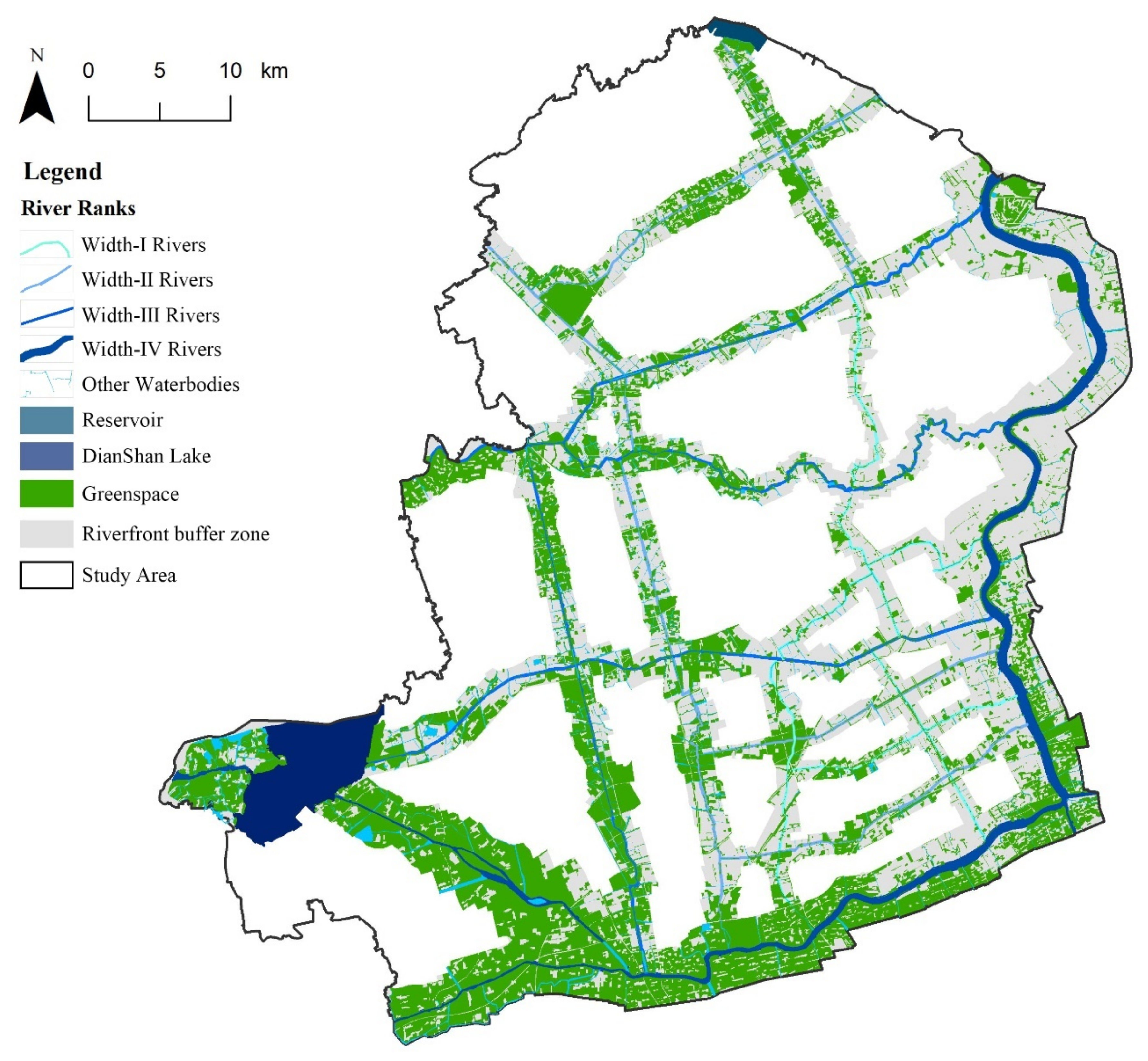
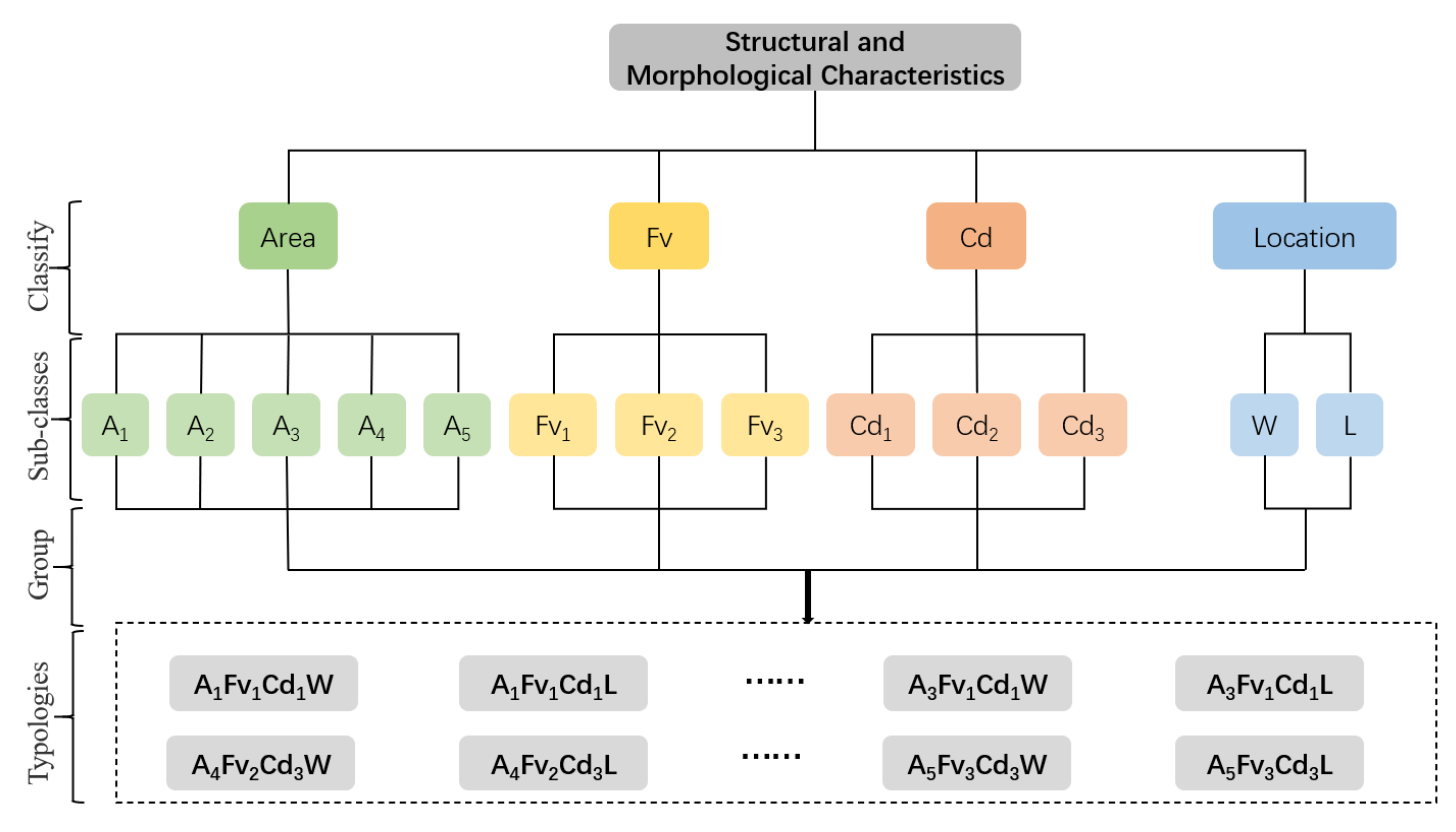
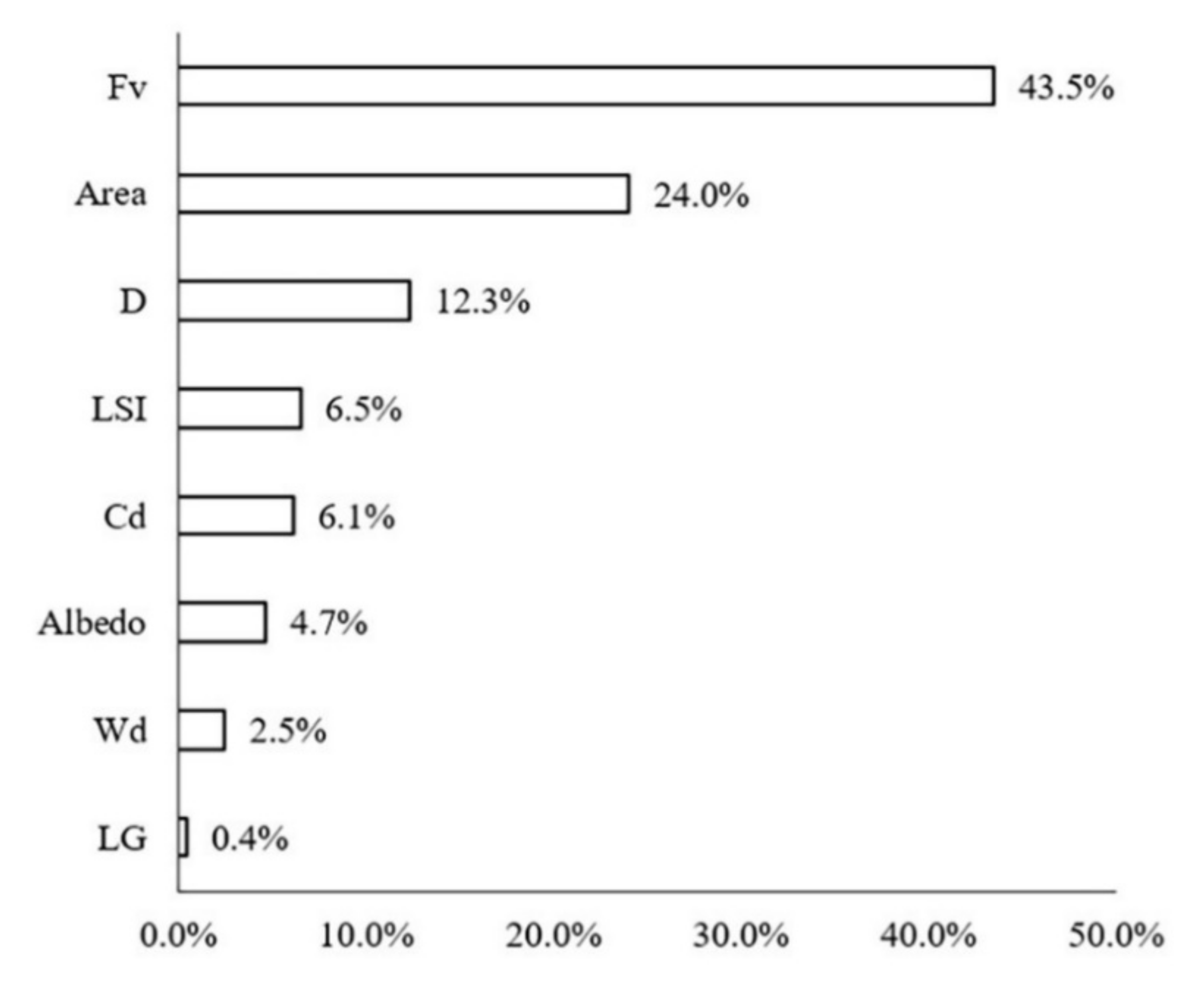




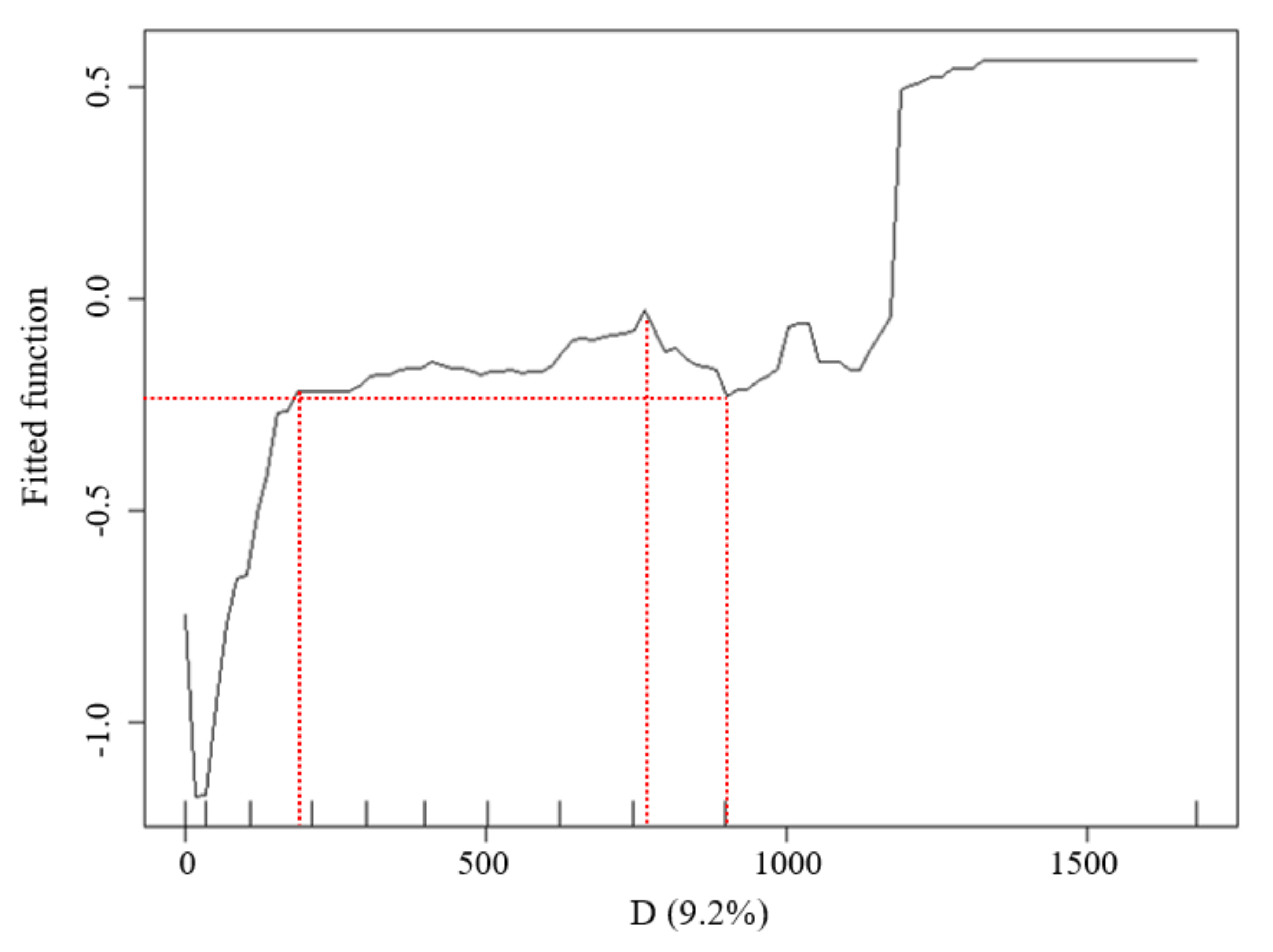
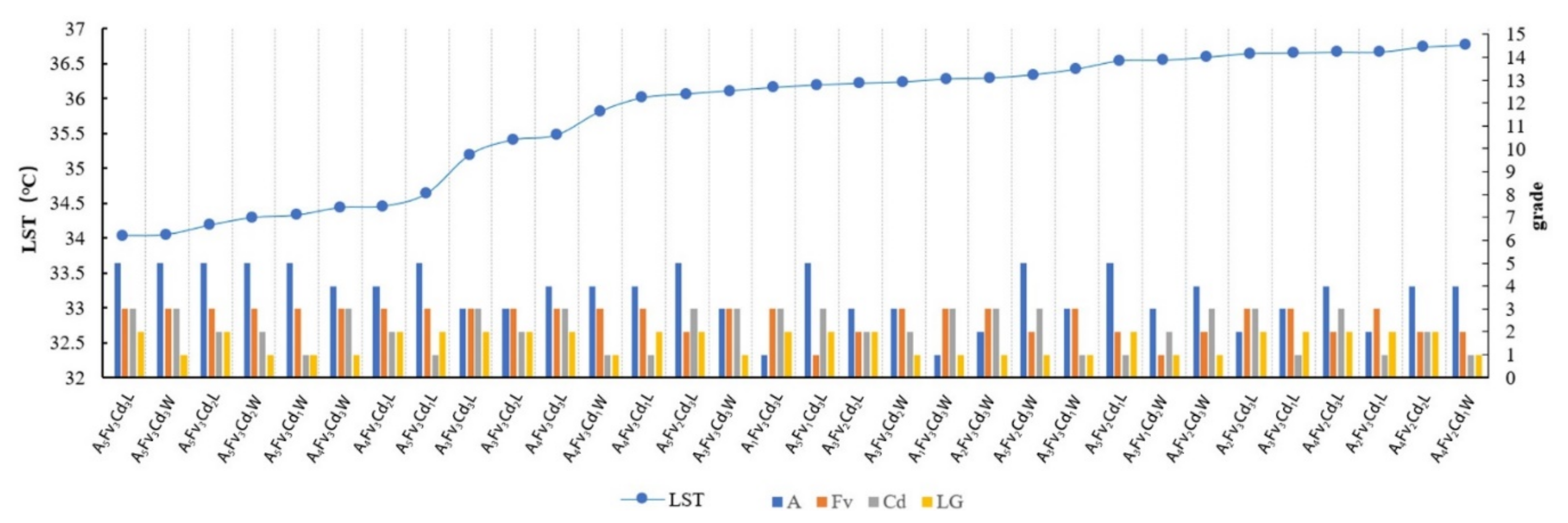
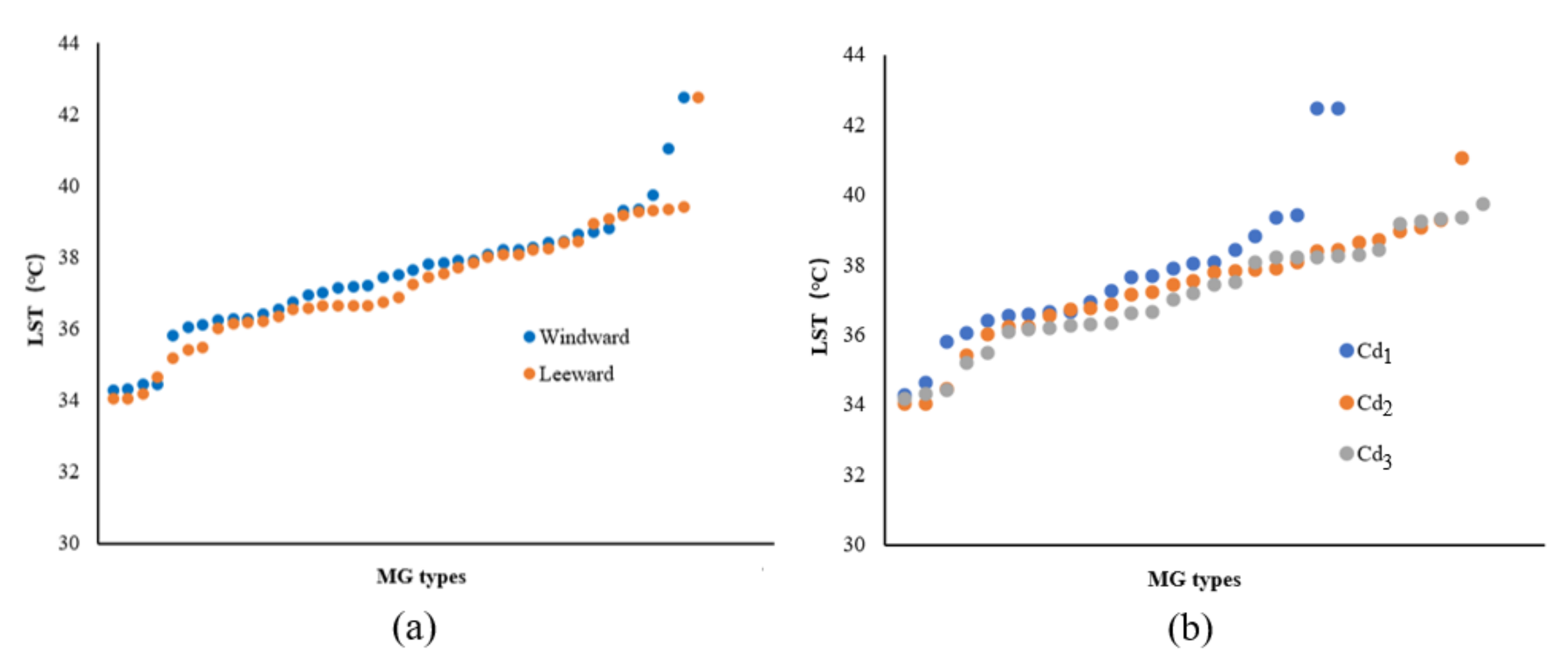
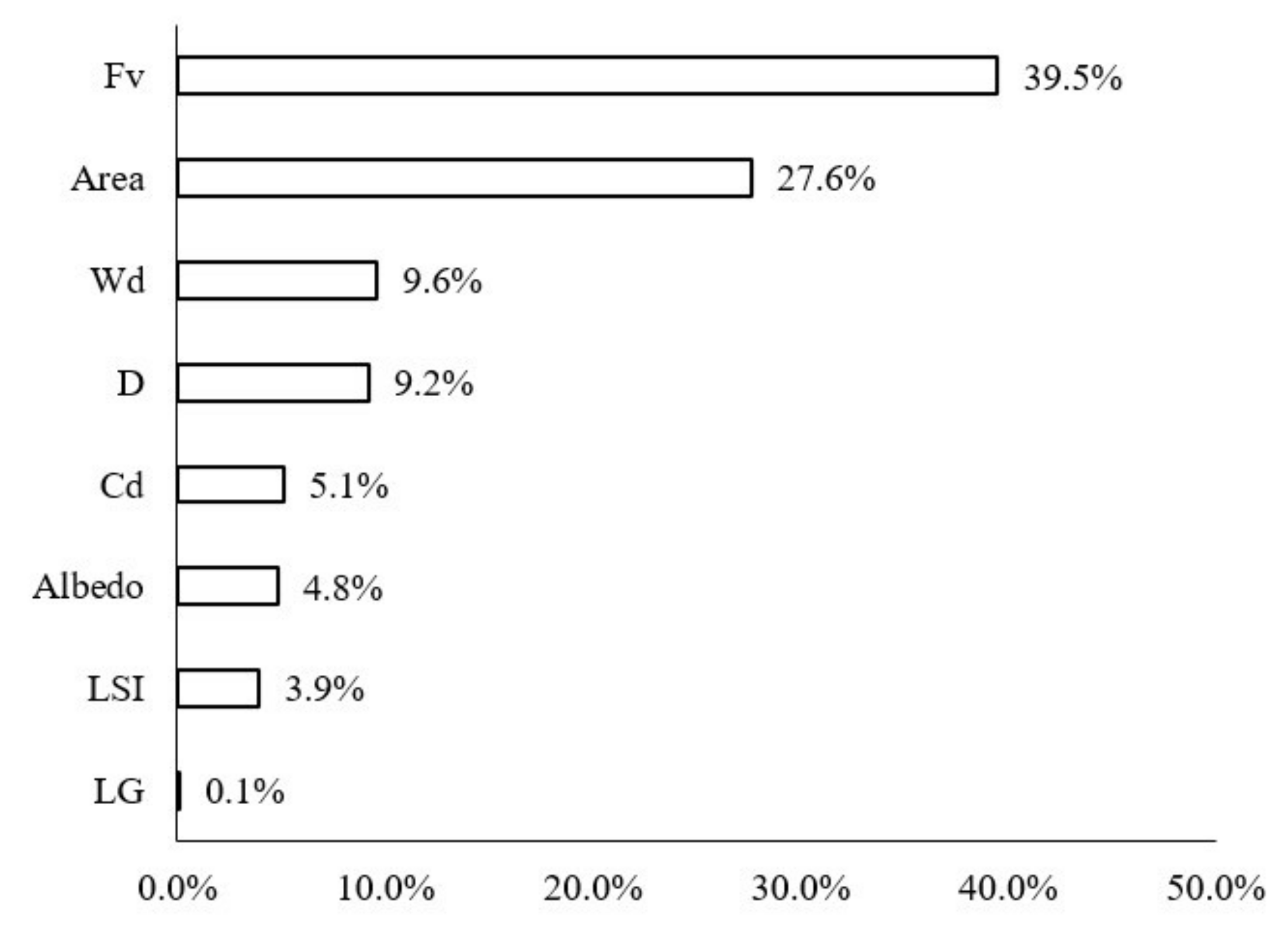

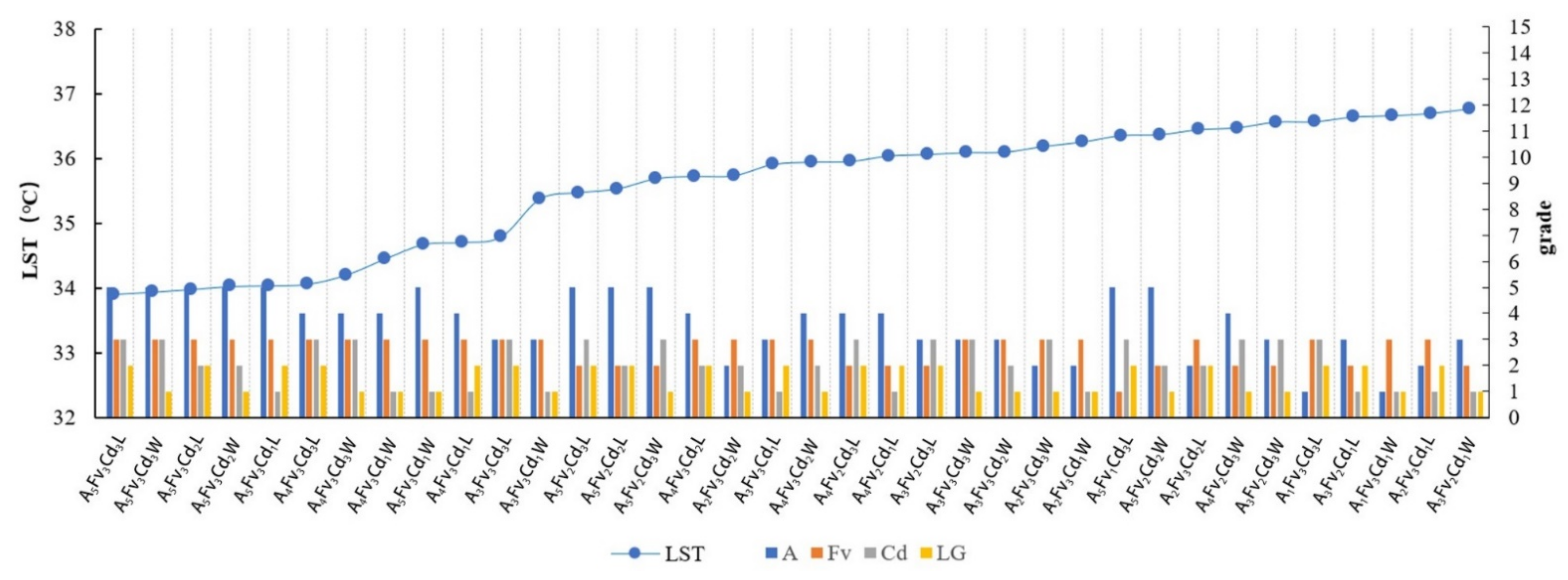

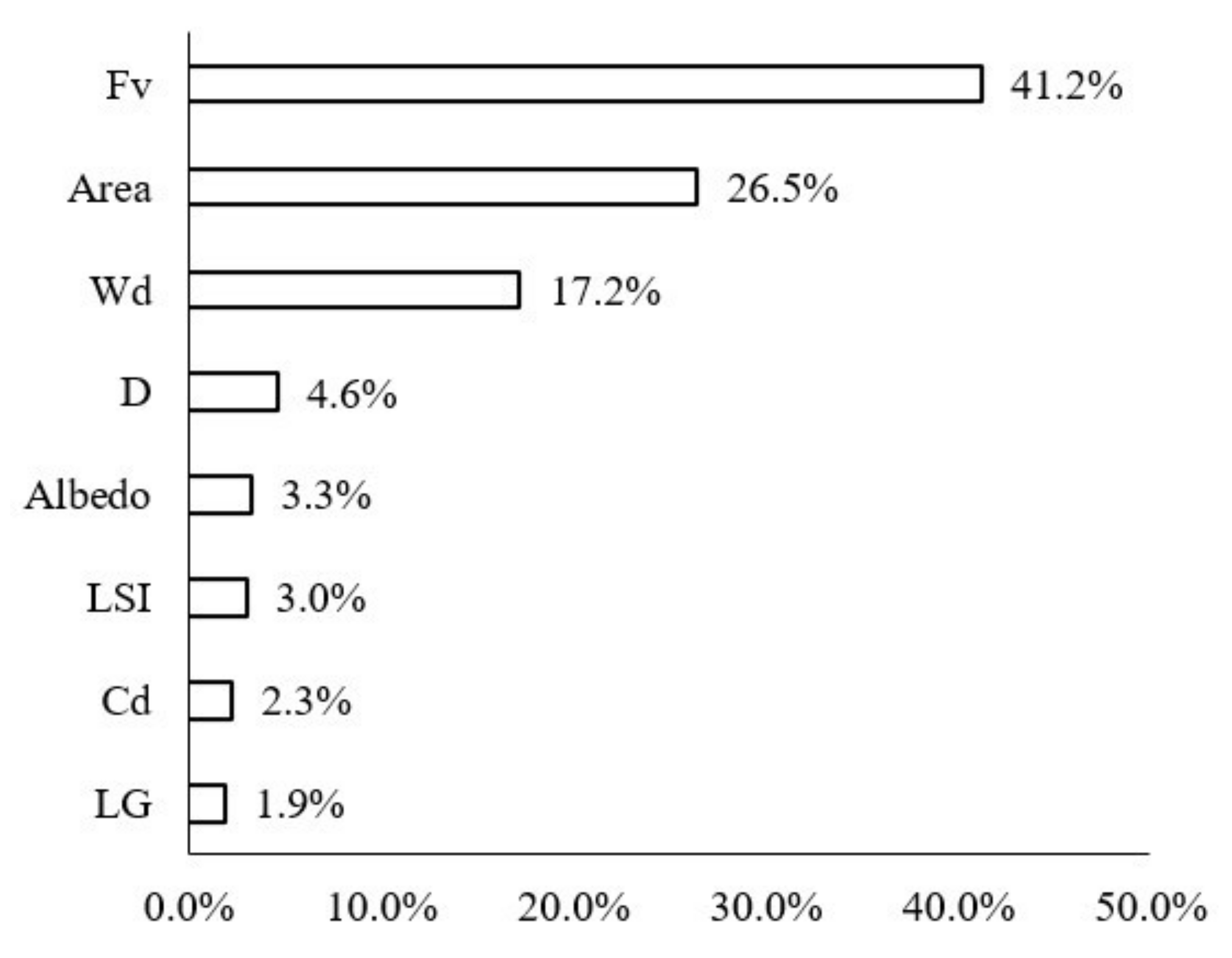
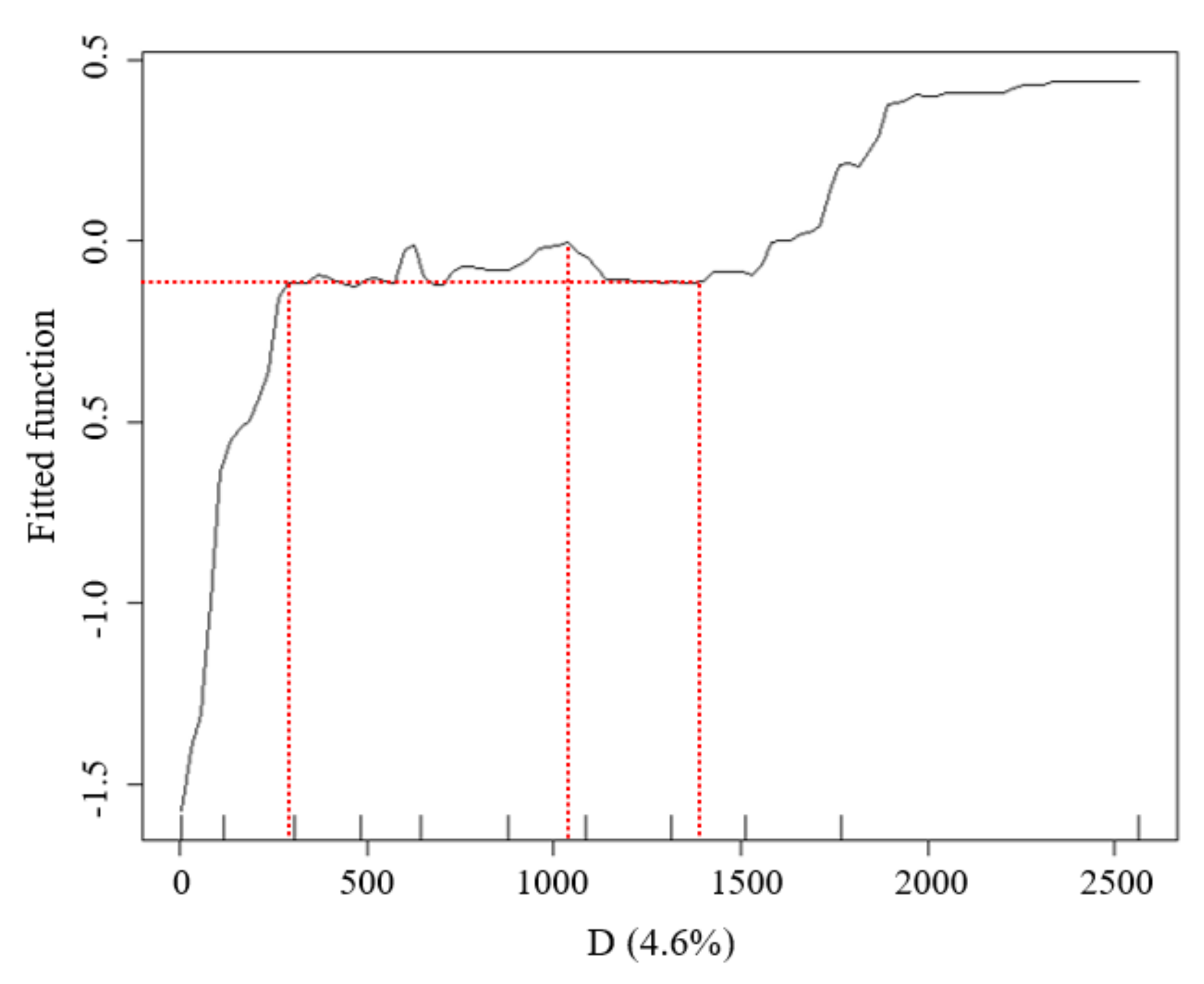

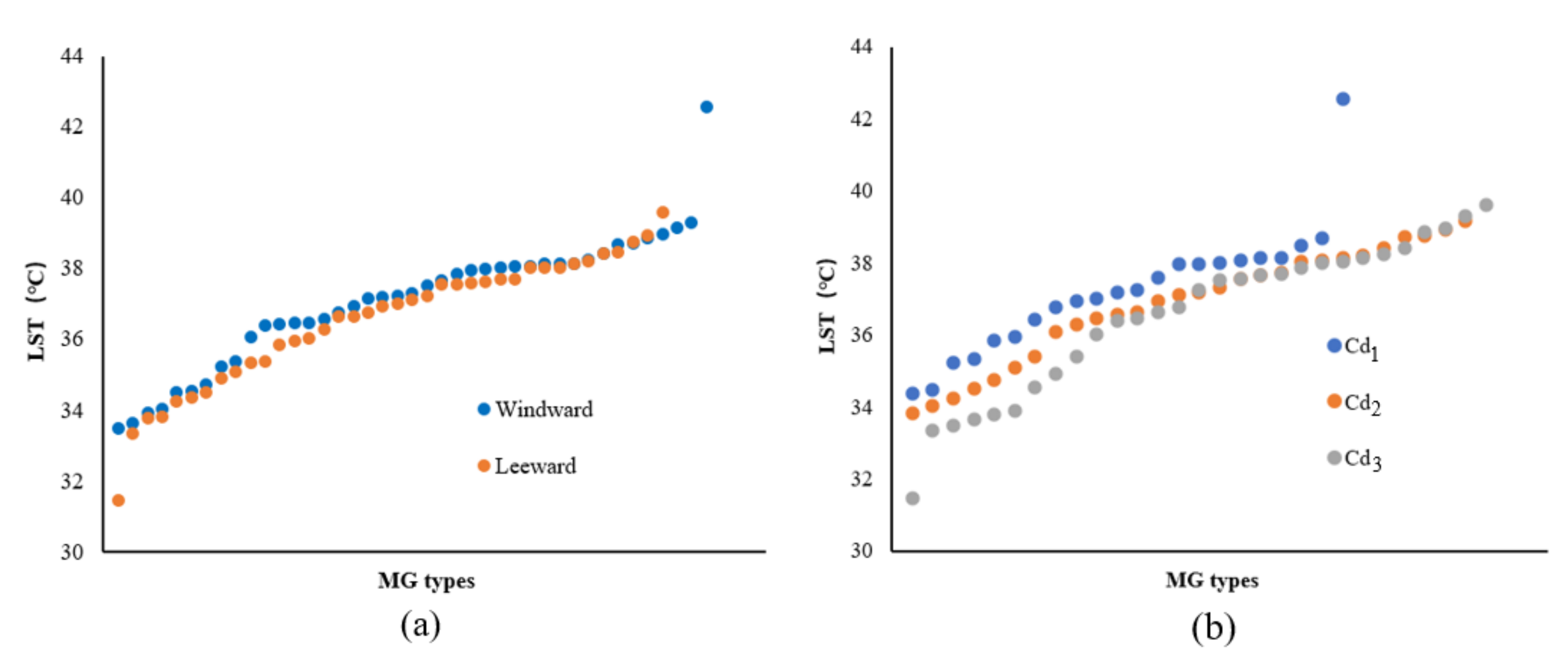

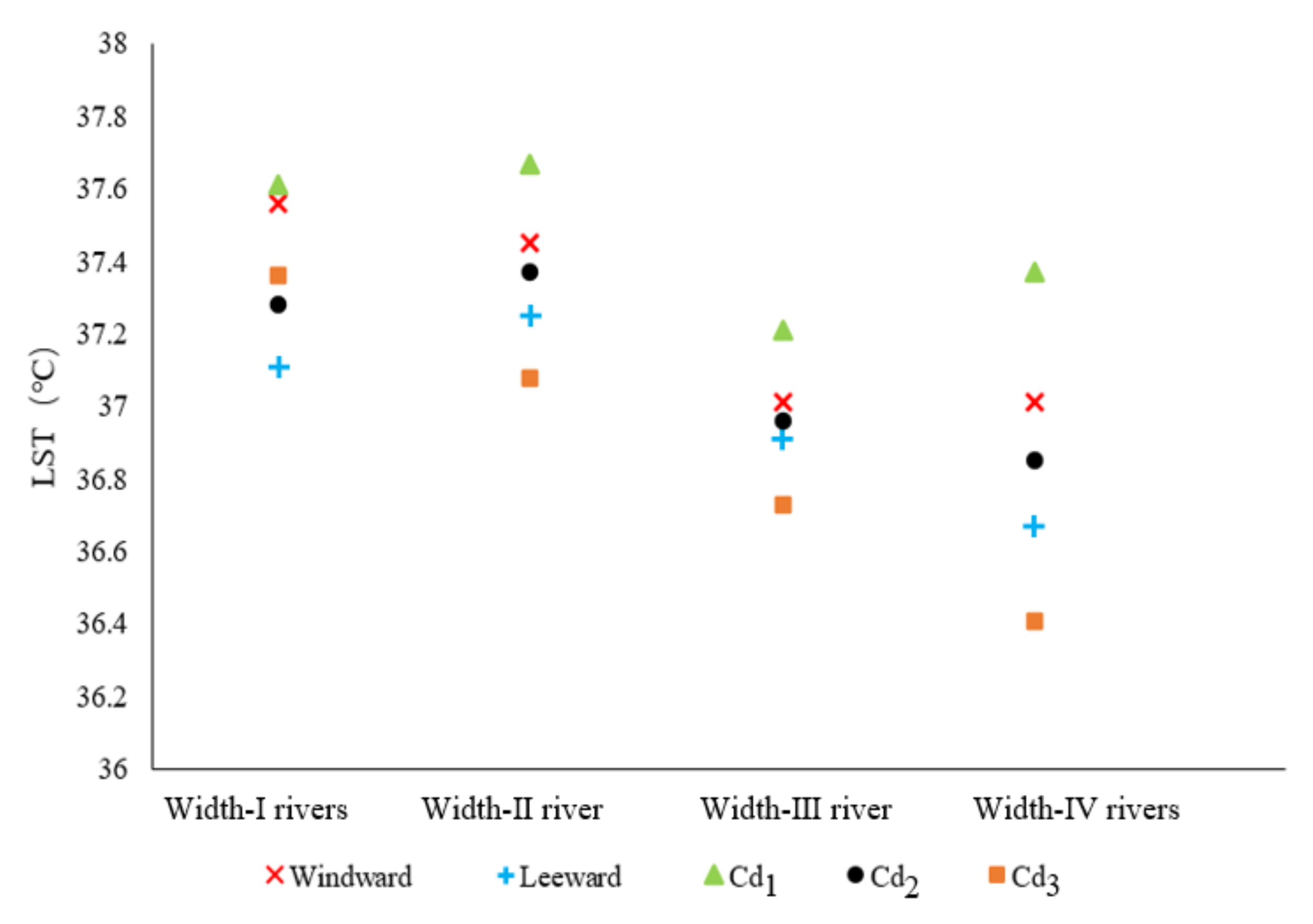
| Impact Variables | Selected Index | Definition and Description |
|---|---|---|
| Variables of the spatial morphology of green spaces | Area | Surface area occupied by the green space in units (m2). |
| Fraction of the vegetation coverage (Fv) | Reflects the vertical coverage of the tree crown; the value of Fv ranges from 0 to 1. | |
| Landscape shape index (LSI) | Indicates the complexity of shapes, determined by calculating the deviation between the shape of the green space patch and a square of the same area. | |
| Albedo | Ratio of the surface reflection flux to the incident solar radiation flux on the surface of the green space. Corresponding data obtained through the Landsat 8 data retrieved through the ENVI5.3 software. | |
| Variables of the spatial structure between blue and green spaces | Location of the green space (LG) | Position of green space relative to the river, defined based on the dominant wind direction and position of the green space relative to the river. |
| Connectivity degree (Cd) | Connectivity degree of the blue–green ecological network, determined using the dPC index in this study and calculated using the Conefor Sensinode 2.6 software. | |
| River width (Wd) | Width of each green patch adjacent to the river. | |
| Distance of the waterfront green space from the riverbank (D) | Distance between the geometric center of the green space and riverbank, representing the influence of the waterbody on the cooling effect of the green space. |
| Classification Aspects of Variables | Area (ha) | Fv | Cd | LG | |||||||||
|---|---|---|---|---|---|---|---|---|---|---|---|---|---|
| Variable classification | A1 | A2 | A3 | A4 | A5 | Fv1 | Fv2 | Fv3 | Cd1 | Cd2 | Cd3 | W | L |
| Value interval | <1 | 1–5 | 5~10 | 10–20 | >20 | <0.4 | 0.4–0.7 | 0.7–1.0 | 0–2 | 2–10 | >10 | ||
| Meaning | smallest | smaller | intermediate | larger | largest | low | middle | high | low | middle | high | windward | leeward |
Publisher’s Note: MDPI stays neutral with regard to jurisdictional claims in published maps and institutional affiliations. |
© 2021 by the authors. Licensee MDPI, Basel, Switzerland. This article is an open access article distributed under the terms and conditions of the Creative Commons Attribution (CC BY) license (https://creativecommons.org/licenses/by/4.0/).
Share and Cite
Jiang, Y.; Huang, J.; Shi, T.; Wang, H. Interaction of Urban Rivers and Green Space Morphology to Mitigate the Urban Heat Island Effect: Case-Based Comparative Analysis. Int. J. Environ. Res. Public Health 2021, 18, 11404. https://doi.org/10.3390/ijerph182111404
Jiang Y, Huang J, Shi T, Wang H. Interaction of Urban Rivers and Green Space Morphology to Mitigate the Urban Heat Island Effect: Case-Based Comparative Analysis. International Journal of Environmental Research and Public Health. 2021; 18(21):11404. https://doi.org/10.3390/ijerph182111404
Chicago/Turabian StyleJiang, Yunfang, Jing Huang, Tiemao Shi, and Hongxiang Wang. 2021. "Interaction of Urban Rivers and Green Space Morphology to Mitigate the Urban Heat Island Effect: Case-Based Comparative Analysis" International Journal of Environmental Research and Public Health 18, no. 21: 11404. https://doi.org/10.3390/ijerph182111404






